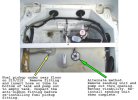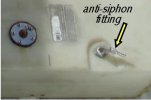- State
- Florida
Other than my eyesight going South at times from the effects of CVS thus forcing me to jack up the size of fonts I now use as compared to my older posts (wondered if anybody else noticed?)  Dave is very cool and really too much so and needs some heat! Thus no need to worry
Dave is very cool and really too much so and needs some heat! Thus no need to worry  But thanks for the concern
But thanks for the concern  Dave does have a lot of irons in the fire and my right hand now has taken the almost constant shape of a "mouse" (like a Talon) which by the way happens to get worse when it does not get to grip a bait caster for too long of a period! Ha-Ha... Fish more and work less we all need to do
Dave does have a lot of irons in the fire and my right hand now has taken the almost constant shape of a "mouse" (like a Talon) which by the way happens to get worse when it does not get to grip a bait caster for too long of a period! Ha-Ha... Fish more and work less we all need to do 
I think the video above covered all the above topics including how the OEM's may not cover Warranty related issues. I also think it has some merit in showing how using that fuel even with a system not designed for such much like a modern outboard, did not show much effects and in some ways cleaner. From a purely engine deposit standpoint like running a Diesel on "Bean Oil" as we called it years ago, is cleaner than crude oil based fuels. I say this because not because you can compare both engines in all functions, but can in one aspect... What is left behind after you "burn" the various types of fuel.
Now I do not like how the use of such fuel has been "crammed" down our tanks. I do not cotton to the lack of choices at all and see this a overreach of power like many other things. And I do not think that sectors of Uncle Exxon are very happy about such either, but we will pass on that topic for a later time over a few Mojito's
Water in fuel though has been a constant battle since the first days of fuel storage. And as I made mention, can be a hassle no matter what is dumped into the tank.
Rubber fuel lines (though I question the quality and materials of lines actually tested) is reported to have issues with E10. Then again, others report it does not so not much of a constant there and loops back to who's wallet is looking to grow on either side of that debate.
Be that as it may, there now is a new product I found that claims to actually control both issues This and presents a video from Ship Shape TV on how it does just that. So I submit for your viewing and buying consideration to help combat both of those issues this link which if actually works as stated and shown, should (n theory) pretty much put all fears aside
This and presents a video from Ship Shape TV on how it does just that. So I submit for your viewing and buying consideration to help combat both of those issues this link which if actually works as stated and shown, should (n theory) pretty much put all fears aside 
Formula X2 - Home
Best,
Dave
I think the video above covered all the above topics including how the OEM's may not cover Warranty related issues. I also think it has some merit in showing how using that fuel even with a system not designed for such much like a modern outboard, did not show much effects and in some ways cleaner. From a purely engine deposit standpoint like running a Diesel on "Bean Oil" as we called it years ago, is cleaner than crude oil based fuels. I say this because not because you can compare both engines in all functions, but can in one aspect... What is left behind after you "burn" the various types of fuel.
Now I do not like how the use of such fuel has been "crammed" down our tanks. I do not cotton to the lack of choices at all and see this a overreach of power like many other things. And I do not think that sectors of Uncle Exxon are very happy about such either, but we will pass on that topic for a later time over a few Mojito's
Water in fuel though has been a constant battle since the first days of fuel storage. And as I made mention, can be a hassle no matter what is dumped into the tank.
Rubber fuel lines (though I question the quality and materials of lines actually tested) is reported to have issues with E10. Then again, others report it does not so not much of a constant there and loops back to who's wallet is looking to grow on either side of that debate.
Be that as it may, there now is a new product I found that claims to actually control both issues
Formula X2 - Home
Best,
Dave


